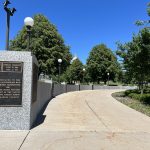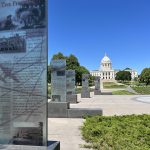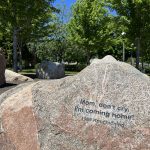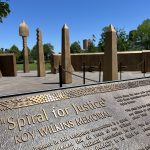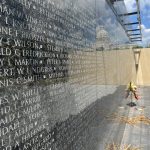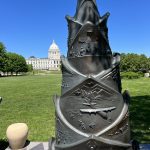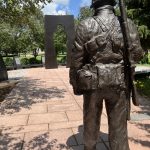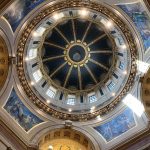1 Introduction: A Minnesota Story of America’s Past
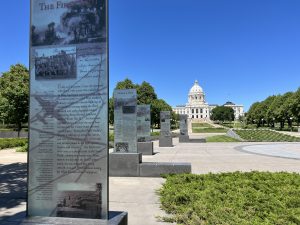
For the better part of the past two decades, I have had the pleasure of teaching a Minnesota history course at Saint Paul College. At the beginning of each semester, I tell my students that geographically there is no better place to study Minnesota’s past than at our college. Located in Saint Paul’s Cathedral Hill Neighborhood near the interchange of interstates 35E and 94, the college is within eyesight or walking distance of a surprising amount of the city’s and state’s heritage. So, it makes sense then to begin our investigation of Minnesota’s past by simply taking a quick look around our campus.
Dakota Ancestral Homeland
Saint Paul College is located on the ancestral homelands of the Dakota people. Many gatherings, events, and meetings at the college begin by acknowledging this fact. Later in this account of Minnesota’s history, we will investigate the painful story surrounding the federal government’s acquisition of Dakota and Ojibwe lands in Minnesota and beyond.
Historic Cathedral Hill
Section Highlights
- Saint Paul College is located in Saint Paul’s Cathedral Hill Neighborhood
- A walk along John Ireland Blvd and Summit Avenue, brings us by:
- The Sailors and Soldiers Memorial
- The Cathedral of Saint Paul
- The abandon Selby Avenue street car tunnel
- The James J Hill House
- The Frederick Weyerhaeuser House
- Summit Overlook Park
- Nina Clifford wooden statue
- The apartment where F. Scott Fitzgerald wrote This Side of Paradise
Departing campus and heading in a westerly direction along John Ireland Boulevard, we first meet with the Sailors and Soldiers Memorial that honors the state’s contributions to the Civil War. Atop the pedestal stands a statue of Josias King – purportedly the first volunteer for the First Minnesota Volunteer Regiment which was the first in the nation to be offered to President Lincoln in defense of the Union. Unknown or unacknowledged when the memorial was erected in 1903, is the fact that King also took part in the Punitive Expeditions in the wake of the US Dakota War of 1862. Further, he is believed to have participated in the Massacre of Whitestone Hill in which the US military massacred hundreds of Dakota people in North Dakota in September of 1863. King’s presence in the memorial reminds us that there is almost always more to the story and that our history can be complicated, difficult, and painful. As the nation struggles with memorials to the Confederate cause that are spread throughout the South, Minnesota has its own, although a bit different, controversy.
A couple-minute walk along John Ireland Boulevard just as it transitions into Summit Avenue takes us to the Cathedral of Saint Paul. Constructed between 1906 and 1915, the Roman Catholic Cathedral is the fourth to exist in Saint Paul and soars 306 feet into the sky. The “ambitious and magnificent” structure was built under the direction of John Ireland, an Irish potato-famine immigrant who came to Minnesota in 1852 at age 14 before becoming a priest and then ordained as the Archbishop of Saint Paul in 1888. In addition to the Cathedral of St. Paul, Ireland founded Saint Thomas University in 1885, and oversaw the construction of the Church of the Immaculate Conception in Minneapolis which opened in 1915 before becoming the Basilica of Saint Mary eleven years later. Saint Paulite Kevin Duchschete summed up Ireland’s contributions to the state well when he wrote that he “was a builder, a politician, a colonizer, an orator, a writer, a diplomat, and a friend to presidents, an Irishman who loved America and a true believer in the promise of Minnesota.”[1]
Diagonally across Summit from the Cathedral, a concrete staircase descends the impressively steep Cathedral Hill. At the bottom of the stairs sits the entrance to a long-ago-sealed-off street car tunnel. Saint Paul’s first street cars were horse drawn carts that began service in the summer of 1872. In the late 1880s, the city experimented with steam-powered cable cars while it contemplated converting everything to electricity. One of the two cable lines began service in 1888 and ran along Selby Avenue, down Cathedral Hill (before the Cathedral was built, it was known as St Anthony Hill) to Lowertown near where CHS Stadium is today. In 1898, the line was converted to electricity, but the electric cars had a difficult time ascending and descending the hill’s steep grade. To alleviate the issue, the street car railway company dug a tunnel through the hill that opened in 1907 and operated through the mid-1950s.
Partially because of the trolley, Selby Avenue became a bustling center of commerce and housed as many as 26 businesses per block. It began a gradual decline during the Depression which accelerated after World War II. In the aftermath of Martin Luther King Jr.’s assassination in April of 1968, Saint Paul, like most major metropolitan areas, endured several nights of violent protests. During the unrest, several of Selby Avenue’s remaining businesses burned, bringing an end to the area’s commercial dominance. Beginning in the mid-1970s, efforts to rejuvenate the Avenue attracted a number of eateries which are today recognized collectively as Restaurant Row. Like much of Minnesota’s history, Selby Avenue’s heritage mirrors the general themes and iconic events – both positive and difficult – of our nation’s past.
Continuing our walk west along Summit Avenue brings us to the beginning of what is purported to be one of the longest stretches of Victorian-era houses still existing anywhere in the nation. The first, most opulent, and well-known of these impressive homes, once belong to James J. Hill. Like Ireland, Hill too was an immigrant. He arrived in Saint Paul from Canada with empty pockets in 1856. Through hard work and shrewd business dealings, Hill became one of the nation’s most successful railroad barons of his day. Known as the Empire Builder, Hill built a network of rail lines that connected Saint Paul to Seattle in the north, and to Denver by way of Chicago and St Louis further south. Hill was not without controversy, his business dealings ran afoul at times with both his workers and the federal government. His imposing 36,500-square-foot home, constructed between 1888 and 1891 by more than 300 craftsmen, is today a historic site administered by the Minnesota Historical Society.
Two doors down from the Hill House, is the home Frederick Weyerhaeuser built for his family in 1884. Weyerhaeuser was also an immigrant. He immigrated from Germany in 1852 before rising out of poverty to become known as the “Timber King.” Using strategies similar to the ones championed by Hill, Weyerhaeuser came to control vast acreage of timber stands, sawmills and paper mills. Continuing west along Summit, which tracks the crest of Cathedral Hill, takes us by home after home each with their own story celebrating the rise of the late 19th-century wealth.
A half-mile walk brings us to Summit Overlook Park and its impressive view of the High Bridge as it spans the Mississippi River from the city’s westside. Adjacent to the park on the north side of Summit Avenue stands the carved wooden likeness of Nina Clifford – Saint Paul’s most infamous madam who is often remembered as “the richest woman of the underworld.” Clifford established a brothel in the city’s Under-the-Hill red light district in the late 1890s that endured for more than forty years until her death in 1929. Her wooden statue stands on a private residence and captures her gazing toward the Minnesota Science Museum which today occupies the spot her brothel once did nearly a century ago. While the historical record is sparse, Clifford clearly played a prominent, decades-long role in the seamier side of Saint Paul’s past – especially during the 1920s when gangsters openly collaborated with police in a city that was far from Saintly.
While the city was preparing to enter the roaring twenties and descend into an era of police-sanctioned corruption that gave its night life a special kind of extra-legal exuberance, in an apartment three blocks beyond the park and Nina’s knowing gaze, F. Scott Fitzgerald wrote his first novel This Side of Paradise. The book appeared in 1920, and propelled the young author into the forefront of a group of American writers called the Lost Generation. Fitzgerald soon became known as the novelist best-able to capture the nation’s jazz-aged culture – a title he secured with his publication of The Great Gatsby in 1925.
Cathedral Hill – Summit Avenue Neighborhood
The Minnesota Historical Society and the Capitol Mall
Section Highlights
- The Minnesota History Center is the administrative headquarters of the Minnesota Historical Society – the oldest cultural organization in the state.
- Interstate 94 was constructed in the 1960s and bisected the Rondo Neighborhood.
- The Capitol Mall contains over two dozen monuments celebrating Minnesota history.
- The Minnesota State Capitol was designed by Cass Gilbert and opened in 1905.
Returning to campus from the Cathedral Hill neighborhood and heading in the opposite direction we encounter more close-at-hand history. Across the Kellogg and John Ireland interchange from our campus sits the Minnesota Historical Society’s History Center. Founded in 1849 shortly after the Federal Government created the Minnesota Territory, The Historical Society is the oldest cultural institution in the state. At an early meeting, Rev. Edward D. Neill advised the society to “Write your history as you go along, and you will confer a favor upon the future inhabitants of Minnesota, for which they will be ever grateful.”[2] The Historical Society did that and more. Today, it is the largest state historical organization in the nation and annually serves three million people through its archives, publications, educational programing, research facilities, online resources, and its extensive network of 26 historic sites. The History Center, an architectural jewel that the Society constructed in 1992, houses the society’s collections, administration, library, archives, and its state museum. For Minnesota history students it is hard to find a better neighbor, especially considering that the Society provides Saint Paul College students access to the History Center Museum at no charge (just bring your college ID).
The Minnesota Historical Society
The Minnesota History Center
NOTE: You can click on these images to enlarge them. After viewing an image, use your browser’s back arrow to return to the book.
Leaving the History Center, and walking northeast along John Ireland Boulevard toward the state capitol, we immediately cross a bridge spanning Federal Interstate 94. Although not immediately obvious, the highway itself holds direct connections to a difficult chapter in Saint Paul’s past. Construction of I-94 was funded by the Federal Aid Highway Act and began in 1956. Over the strenuous objections of the city’s African American population, city planners routed the highway through the Rondo neighborhood – a vibrant and nearly self-sustaining African American community. Perhaps as much as 80% of the city’s African American population lived in Rondo at the time, and most of the over 700 homes destroyed by the project were Black-owned. In addition, the highway construction resulted in some 300 businesses being torn down or forced to close. Inadequate compensation and the city’s discriminatory housing and commercial real-estate policies proved economically devastating for those displaced. Without question, the bisection of Rondo is an example of what is sometimes called systemic racism – the result of which caused generational disadvantages for Saint Paul’s Black population.
But if Rondo is a story of dislocation and hardship, it is also a story of resilience. Community push-back to the construction was quick and extensive. Although not able to change the route, the Rondo community did succeed in altering the project from an imagined elevated highway to a sunken design that was at least a bit less intrusive. Further, during the 1980s, community organizers established a neighborhood celebration, Rondo Days, that sought to “bring back a sense of community, stability, and neighborhood values of the old Rondo community.” Most recently, in 2021, the Minnesota legislature provided $6.8 million to begin planning the Reconnect Rondo Project. The redevelopment plan aims to build a five-block land bridge over I-94 between Grotto and Chatsworth Streets, providing space for housing, arts, and businesses while reconnecting a portion of Old Rondo.
Continuing on toward the Capitol, now on the north side of I-94, we soon enter 18 acres of open green space extending out from the Capitol’s main entrance. This “Capitol Mall” houses over two dozen monuments and memorials celebrating Minnesota’s past, noting its contributions to the nation’s conflicts, and honoring its peoples’ heritage. From Scandinavian and European explorers to Minnesota Hmong soldiers – the Capitol Mall is an inclusive expanse highlighting our state’s history. Politicians, suffragists, laborers, Civil Rights activists, Indigenous communities, veterans, police officers, fire fighters, and others are all honored on the state’s “front lawn.”
The Minnesota Capitol Mall
- Court of Honor
- WW II Memorial
- Military Family Tribute
- Roy Wilkins Memorial
- Vietnam Memorial
- Laos Special Forces Memorial
- Workers Memorial
- Korean War Veterans Memorial
NOTE: You can click on these images to enlarge them. After viewing an image, use your browser’s back arrow to return to the book.
The most striking aspect of the Capitol Mall is, of course, the capitol building itself. First opened to the public in 1905, the imposing building was designed by St. Paul architect Cass Gilbert and became the third structure to serve as Minnesota’s capitol. Built of stone and marble from Minnesota and across the globe, the capitol is, according to Brian Pease, “one of the great Minnesota success stories in public architecture and construction.”[3] Massive in size, the structure is dominated by a capitol dome that soars 142 feet into the sky and houses a 92-bulb chandelier that spans six feet. A year after the building opened, Minnesotans added the iconic sculpture of a golden chariot pulled by four horses at the base of the dome and above the main entrance. Minnesotans simply refer to the sculpture as the quadriga (“four-horse chariot” in Latin), but its official title is “The Progress of the State.”
Not only is the capitol the seat of state government, it is also a public space Minnesotans use to remember its past and celebrate its heritage. The architecture and artwork are filled with references to Minnesota’s history – a characteristic that is pointed out during free guided tours provided by the Minnesota Historical Society. But as we have already realized, history is complicated and attempting to interpret it in public spaces is challenging. This reality bubbled to the surface recently when members of Minnesota’s American Indian community voiced their discomfort with two historic paintings that adorned the Governor’s Reception Room. One painting inaccurately depicts Father Louis Hennepin’s visit to St Anthony Falls in 1680, a second is an imagined scene from negotiations of the Treaty of Traverse des Sioux in 1851 – a very painful and disastrous event for Minnesota’s Dakota people. Because of their prominence, the paintings often appeared as backdrops when the governor addressed the state on television – leaving no ability to offer interpretation of the controversial imagery. To address the understandable concerns while continuing to display the artwork that in itself is historic (they were commissioned for the capitol opening in 1905), a legislative committee moved the paintings to a gallery elsewhere in the capitol where they can be more fully interpreted and yet remain available for public view.
The Minnesota State Capitol Building
NOTE: You can click on these images to enlarge them. After viewing an image, use your browser’s back arrow to return to the book.
Venturing only a short distance from our campus, we can learn a lot about our state’s past. At times, connections to our history are obvious – as they are at the Historical Society or the State Capitol. At other times, our past is all but hidden by what came after – as it is with the long-abandoned Selby Streetcar Line, or the much-altered Rondo Neighborhood. And there are times, those connections are more complicated then they first seem – as they are with Josias King’s presence in the Sailors and Soldiers Memorial or with historic but inaccurate paintings displayed in our capitol. In all cases, our history is there for us to investigate and contemplate as we try to make sense of our present.
Minnesota Exceptionalism?
Section Highlights
- Minnesota is both exceptional and representative of the American experience.
- Minnesota’s past contains aspirational stories and painful events – both have lasting legacies.
Thinking about Minnesota beyond what we can see and walk to from our campus, I often ask students at the outset of a new semester to create a list of things about the state that they think are exceptional. Without fail, this generates a far-reaching conversation that spans history, geography, politics, technology, environmentalism, innovation, and culture. Saint Paul College students, like many Minnesotans, are proud of their state. Students consistently mention Minnesota’s geography, the Boundary Waters, the 15,000 lakes, Dakota and Ojibwe heritage, the Mayo Clinic, the state’s colorful political history and specific politicians, the iron range and the steel it produces, the arts and music scene in the Twin Cities, environmental stewardship, the Mall of America, and diverse immigrant communities, as examples of Minnesota’s exceptionalism.
Likewise, Minnesota politicians often paint a picture of Minnesota as an exceptional place. An interesting example of this came in January of 2003 when Tim Pawlenty became Minnesota’s 39th governor. That he succeeded Governor Jesse Ventura, a former professional wrestler, actor, and radio host, was a nod to Minnesota’s unique political heritage that since the 1920s has been more open to third-party campaigns than most other states. Pawlenty’s inaugural address boasted of the state’s “wide-open spaces… productive farm fields and bustling communities,” touted the growing diversity of Minnesotans, and presented an impressive list of the state’s contributions to the nation and the world.[4]
Pawlenty went on to make a concise argument for Minnesota exceptionalism. The state, the new governor argued, has a well-earned reputation as a leader in medical care. In the 1880s, the Mayo brothers established what would become the world-renowned Mayo Clinic in Rochester. In the 1940s, Minnesota embraced Sister Kenny’s alternative and effective Polio treatment and established the Sister Kenny Institute. More recently, Minnesotans led the way in the invention of pacemakers and defibrillators. To continue to highlight the state’s innovation, Pawlenty recounted Minnesota-born Charles Lindbergh’s first transatlantic flight in 1927, the development of taconite processing methods on the Iron Range during the 1950s, the creation of drought-resistant hybrid wheat and rice variants that helped address mid-20th-century world hunger, and, more recently, the development of corn-based ethanol fuels. He went on to credit Minnesotans with the invention of snowmobiles and thermostats before listing other innovations, including: “scotch tape, water skis, post-it notes, Sears and Roebuck, the Pillsbury doughboy, Greyhound Bus Lines, Meals on Wheels, group medical practice and even our beloved Spam.” The new governor boldly concluded “Minnesota has made the world a much better place because the world gives us problems — and we give it progress.”[5]
Historians have also, at times, presented Minnesota as an exceptional place. Norman Risjord, concluded his 2005 A Popular History of Minnesota with a chapter titled, “Minnesota Exceptionalism.” After admitting that the growth of 20th-century federal governmental reach along with mass media and “instantaneous communications” have reduced distinctions between states and regions, Risjord argued that “Minnesotans have managed to retain their self-image of exceptionalism.”[6] He went on to discuss the Mayo Clinic; Lindbergh’s flight; the arts, music, and theater in the Twin Cities; the extensive state park system; the Boundary Waters Canoe Area; and, finally, the controversy surrounding pollution generated by taconite processing on Minnesota’s North Shore.
While these Minnesota accolades are not misplaced or inappropriate, there is more to the story. First, the state’s history can just as easily be presented as representative or reflective of the American experience. In fact, Minnesota’s exceptionalism, or uniqueness, can be best understood in the context of the broader picture of American history. The following chapters, therefore, attempt to draw-out the connection between state and national history and tell a Minnesota story of America’s past.
Second, as my students often point out when creating their lists of Minnesota exceptionalism, the state’s history is filled with difficult stories that have troubling legacies we are living with today. Clearly, not all of the state’s past is something to be celebrated. Like the nation, Minnesota has struggled with what historian Joseph Ellis has characterized as the “failure to implement a just and generous settlement with the Native Americans.”[7] The painful shortcomings of the treaty making process used by the federal government to acquire Dakota and Ojibwe lands in Minnesota reflects this national tragic story. In Minnesota, misguided federal policies led to a brutal war in 1862 that left Dakota and settler communities shattered and concluded with the execution of 38 Dakota men – the largest mass execution in the nation’s history.
Also like the nation, Minnesota has a painful history of race relations. Technically a free state, Minnesotans enslaved people during the 19th-century – mostly in and around Fort Snelling. Early 20th-century Minneapolis earned a reputation as “the capitol of anti-Semitism in the United States,”[8] while the twin cities developed housing policies that created a rigidly segregated metropolitan area. North of the Twin Cities, white residents in Duluth lynched three young African American men in the summer of 1920. Mid-20th century highway construction and urban renewal projects displaced African American and Mexican-American communities. And the late 1960s brought urban race-based violence to the Twin Cities just as it did across the nation. While Civil Rights era protests and advocacy brought reforms, inequalities persist and have resulted in strikingly different living experiences between white Minnesotans and Minnesotans of color. Despite concerted efforts aimed at reform, by many measures inequalities today are more pronounced than they were during the 1960s.
As we embark on our study of Minnesota history, it is beneficial to accept that the state’s past is both exceptional and representative. That it includes aspirational stories that should be celebrated and heart-wrenchingly difficult events that need to be acknowledged. Both of these Minnesota stories exist together and are connected – and both need to be understood so we can collectively chart a course forward. Stanford historian James T. Campbell recently commented that “We are humans, after all, and our pasts, both individual and collective, include elements that are gracious and honorable and other elements that are grievous and horrifying.”[9] Although his comments came in a discussion about controversial Confederate Monuments, they can just as easily be applied to Minnesota’s past.
Potential, Paradox, and Gateway
Section Highlights
- Our past and present are filled with potential.
- Many aspects of Minnesota history are paradoxical.
- The “Minnesota Paradox” results in today’s vastly different experiences of white and Black Minnesotans
- History textbooks, like this one, are meant to be gateways – not destinations.
The title of our text: Potential and Paradox: A Gateway to Minnesota’s Past has three consequential words – potential, paradox, and gateway – that carry meaning for the book’s approach. Potential reminds us that our past was not predestined. Historical actors, men and women, created our history. Every event had the potential to turn out differently and at every point, decisions and human action dictated how our past unfolded. Understanding this concept collectively – appreciating how human actions acted on potential and created the world we have today – is, in a very basic way, one reason we study history. How we act on potential in our own lifetimes without question will define our future – and understanding our past will help us make informed, beneficial decisions.
Paradox suggests that things are not always what they seem. There are contradictions in our past and in our present that can be understood only through a working knowledge of our history. American history is full of paradoxes – the most infamous being fighting for liberty during the American Revolution while continuing to enslave large portions of the population. Minnesota too has its paradoxical history. The state’s past is filled with an abundance of stories Minnesotans can rightly take pride in. But these inspiring aspects of the state’s past sit uneasily alongside some really difficult history – including, but sadly not limited to, the dismal treatment of Minnesota’s indigenous people, periods of stringent intolerance toward immigrants, and consistent, at times violent, discrimination aimed at African Americans.
The past is complicated – and so too is the present. A painful history surrounding the treatment and opportunities afforded to Minnesotans of color led University of Minnesota Economist, Samuel L. Myers Jr., to assert that there is a clear Minnesota Paradox. This paradox explains how the state can be one of the best places to live by a variety of measures for white people, but at the same time be one of the most difficult places to live for people of color. Myers points out that “measured by racial gaps in unemployment rates, wage and salary incomes, incarceration rates, arrest rates, home ownership rates, mortgage lending rates, test scores, reported child maltreatment rates, school disciplinary and suspension rates, and even drowning rates, African Americans are worse off in Minnesota than they are in virtually every other state in the nation.”[10] In devastatingly brutal fashion, the Minnesota Paradox was put on international display on May 25, 2020, when Minneapolis police officer Derek Chauvin murdered George Floyd as shocked bystanders streamed the gruesome event on social media. The murder drew worldwide condemnation. That it happened in Minneapolis, a city with a troubled racial past, is not unconnected with its historical context. To make sense of Minnesota’s past and appreciate how it created our present, we need to understand its paradoxes.
The final consequential word in this book’s title is gateway. Before coming to Saint Paul College, I spent several years working in the education department of the Minnesota Historical Society. Much of my work was connected to administering the National History Day program and, in that capacity, I spent a lot of time working with middle and high school students on history research projects. While at the Historical Society I had the good fortune of working under Tim Hoogland, a seasoned educator who administered the History Day program for the state. Whenever Tim talked with students about studying history, he always reminded them that their textbooks were gateways to our past – not destinations. It is my hope then, that this book serves as a gateway for you and ignites curiosities that will take you far beyond it.
- Roberts, Kate. "Ireland, John (1838–1918)." MNopedia, Minnesota Historical Society. http://www.mnopedia.org/person/ireland-john-1838-1918 (accessed June 3, 2022). ↵
- Annals of the Minnesota Historical Society. 2nd Edition. Saint Paul, Minn., 1850, p. 29. ↵
- Pease, Brian. "Minnesota’s Third State Capitol." MNopedia, Minnesota Historical Society. http://www.mnopedia.org/structure/minnesota-s-third-state-capitol (accessed July 10, 2022). ↵
- Tim Pawlenty, “The text of the Inaugural Address delivered on Jan. 6, 2003 by Tim Pawlenty.” Minnesota Public Radio, July 6, 2022, http://news.minnesota.publicradio.org/features/2003/01/06_newsroom_pawlentyspeech/ ↵
- Pawlenty, “Inaugural Address.” ↵
- Norman Risjord, A Popular History of Minnesota (St Paul, Minn.: Minnesota Historical Society Press, 2005), 232. ↵
- Joseph Ellis, American Creation: The Triumphs and Tragedies at the Founding of the Republic (New York: Vintage Books, 2007) ↵
- “Anti-Semitism in Minneapolis History,” Minnesota Public Radio News, July 6, 2022, https://www.mprnews.org/story/2017/10/18/anti-semitism-in-minneapolis-history ↵
- James T Campbell, “Controversies over Confederate monuments and memorials are part of an overdue racial reckoning for America, says Stanford historian,” Stanford News. July 6, 2022, https://news.stanford.edu/2020/07/16/confederate-monuments-coming-now/ ↵
- Samuel L Myers Jr. “The Minnesota Paradox,” Hubert H. Humphrey School of Public Affairs – University of Minnesota, July 6, 2022, https://www.hhh.umn.edu/research-centers/roy-wilkins-center-human-relations-and-social-justice/minnesota-paradox ↵
Designed to commemorate people who served in the US military during the Civil War, the Soldiers and Sailors Monument in St. Paul (sometimes called the Josias King Memorial) was erected in 1903. Crowning the monument is a statue of Josias R. King, who is widely regarded as the first US volunteer in the Civil War. King also participated in violent campaigns to punish Dakota people after the US–Dakota War of 1862, known as the Punitive Expeditions. These included the Massacre of White Stone Hill, in which the US military killed hundreds of Native men, women, and children. King's participation in the massacre has complicated his presence in the monument.
Peter DeCarlo, MNOpedia - https://www.mnopedia.org/thing/soldiers-and-sailors-memorial-st-paul
There have been four Roman Catholic cathedrals in St. Paul. The first three were built between 1841 and 1858. The fourth, and the most architecturally distinctive, opened in 1915. Since then, no building in the Twin Cities has approached it in ambition or magnificence.
Paul Nelson, MNOpedia - https://www.mnopedia.org/structure/cathedral-st-paul
Born in County Kilkenny, Ireland, in 1838, John Ireland came to St. Paul with his parents in 1852. He was ordained a Catholic priest in 1861, served briefly as chaplain for the Fifth Minnesota Volunteer Infantry Regiment in the Civil War, and was appointed bishop in 1875. By the time he was appointed archbishop of St. Paul in 1888, he was one of the city's most prominent citizens, and he was responsible for recruiting Irish immigrants to settle in communities throughout Minnesota, including Clontarf, Adrian, Graceville, and Ghent.
Kate Roberts, MNOpedia - https://www.mnopedia.org/person/ireland-john-1838-1918
James J. Hill fit the nickname “empire builder.” He assembled a rail network—the Great Northern (1878), the Northern Pacific (1896), and the Chicago, Burlington and Quincy (1901)—that stretched from Duluth to Seattle across the north, and from Chicago south to St. Louis and then west to Denver. He was one of the most successful railroad magnates of his time.
Paul Nelson, MNOpedia - https://www.mnopedia.org/person/hill-james-j-1838-1916
Frederick Weyerhaeuser was a prominent, self-made lumber capitalist and millionaire in the Midwest during the Gilded Age. Nicknamed "the Lumber King" and "the Timber King" during a time when lumber ranked alongside iron and the railroads as a source of industry, Weyerhaeuser created a syndicate that controlled millions of acres of timberland. The syndicate also controlled sawmills, paper mills, and processing plants.
Courtney Gregar, MNOpedia - https://www.mnopedia.org/person/weyerhaeuser-frederick-1834-1914
Nina Clifford, a child of immigrants who evolved into the “richest woman of the underworld,” made a name for herself as an affluent sex worker who contributed to the buildup of St. Paul’s downtown Red Light District in the late 1800s. She invited other women to establish their businesses nearby while police sanctioned an environment in which vice could thrive. In spite of a lack of preserved records, standing buildings, and extant photographs related to her business, Nina Clifford remains a legendary madam of St. Paul.
Alexandra Scholten, MNOpedia - https://www.mnopedia.org/person/clifford-nina-1851-1929
This turn of phrase is not my own. I have adopted it from the title of a 1985 article written by Woodrow Keljik.
"When the Saintly City Wasn't," by Woodrow Keljik. In ACE (St. Paul Athletic Club), vol. 65, no. 5 (May 1985): pp. 4-23.
Author F. Scott Fitzgerald is a cultural icon of the Roaring Twenties and the Jazz Age. His work, although largely under-appreciated during his lifetime, reflects the thoughts and feelings of his generation.
Thomas Backerud, MNOpedia - https://www.mnopedia.org/person/fitzgerald-f-scott-1896-1940
St. Paul’s Rondo neighborhood ran roughly between University Avenue to the north, Selby Avenue to the south, Rice Street to the east, and Lexington Avenue to the west. African American churches, businesses, and schools set down roots there in the late nineteenth and early twentieth centuries, creating a strong community. Construction of Interstate-94 (I-94) between 1956 and 1968 cut the neighborhood in half and fractured its identity as a cultural center.
Eshan Alma, MNOpedia - https://www.mnopedia.org/place/rondo-neighborhood-st-paul
On Wabasha Hill, just north of downtown St. Paul, stands Minnesota’s third state capitol building. This active center of state government was built between 1896 and 1905, and was designed by architect Cass Gilbert. Its magnificent architecture, decorative art, and innovative technologies set it apart from every other public building in the state.
Brian Pease, MNOpedia - https://www.mnopedia.org/structure/minnesota-s-third-state-capitol
Father Louis Hennepin, a Recollect friar, is best known for his early expeditions of what would become the state of Minnesota. He gained fame in the seventeenth century with the publication of his dramatic stories in the territory. Although Father Hennepin spent only a few months in Minnesota, his influence is undeniable. While his widely read travel accounts were more fiction than fact, they allowed him to leave a lasting mark on the state.
Kathryn Goetz, MNOpedia - https://www.mnopedia.org/person/hennepin-louis-ca1640-ca1701
The Treaty of Traverse des Sioux (1851) between the Sisseton and Wahpeton bands of Dakota and the US government transferred ownership of much of southeastern Minnesota Territory to the United States. Along with the Treaty of Mendota, signed that same year, it opened twenty-four million acres of land to settler-colonists. For the Dakota, these treaties marked another step in a process that increasingly marginalized them and dismissed them from the land that had been—and remains—their home.
Eric Weber, MNOpedia - https://www.mnopedia.org/event/treaty-traverse-des-sioux-1851
National History Day in Minnesota is a co-curricular program for students in grades 6-12, focusing on historical research and analysis about a topic of their choosing.




